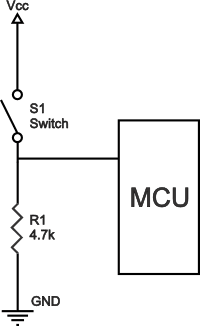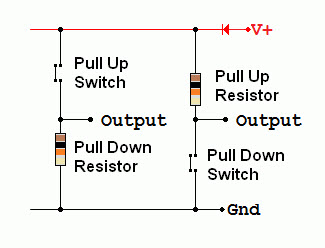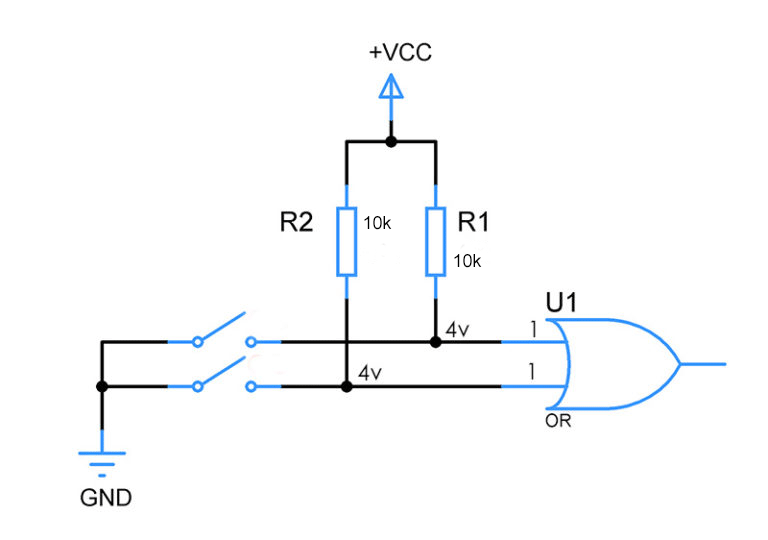Resistors: Pull-up and pull-down resistors
Have you ever thought of why resistors are so commonly used but barely anyone gives them enough credit for what they do? Before we dive into what exactly are pull-up and pull-down resistors, we will have to first understand what are resistors.

Thus, here are some basics you should understand about resistors before we can get started on our main topic today!
Resistors
Resistors are defined as a passive two-terminal electrical component that implements electrical resistance as a circuit element.

Thus, we can say that resistors’ primary job is to regulate or to set the flow of electrons (current) through them by using the type of conductive material from which they are composed.
The symbol that represents resistors:

There are many types of resistors, but they can typically be classified into 4 groups:
- Carbon Composition Resistor – Low wattage values, made of carbon dust or graphite paste.
- Semiconductor Resistor – High frequency/precision surface-mount thin-film technology.
- Wire-wound Resistor – Very high wattage ratings, made of metallic bodies for heat sink mounting.
- Film or Cermet Resistor – Very low wattage values, made of conductive metal oxide paste.
Interested to learn more about resistors? Click here!
Now that we know more about resistors, we can move on to what will be covered in this blog:
- Pull-up resistor
- Pull-down resistor
- Difference between pull-up and pull-down resistor
- Typical applications of a pull-up and pull-down resistor
- Calculate actual values of pull up and pull-down resistor
- Practical Example
Pull-up Resistors
Pull-up resistors are defined as resistors which are used to ensure that a wire is pulled to a high logical level in the absence of an input signal.
This means that pull-up resistors are connected between the voltage supply and the particular pin, they are also commonly found in digital logic circuits.

One thing to know before using a pull-up resistor is the logic states. Logic circuits have 3 logic states: high, low and floating (or high impedance). The purpose of a pull-up resistor is to ensure input pins are equivalent to the voltage of Ground or VCC (Voltage Common Collector). Typically, they are used in combination with switches or transistors as well.
Pull-down resistors
Pull-up resistors are defined as resistors which are used to ensure that a wire is pulled to a high logical level in the absence of an input signal.
This means that pull-down resistors are connected between ground and the appropriate pin on a device. Though they are less common than pull-up resistors, they work the same way as pull-up resistors.

One thing to note about pull-down resistors, it must have a larger resistance than the impedance of the logic circuit, or else it might pull the overall voltage down by too much. This would cause the input voltage at the pin to remain at a constant logical low value.
Difference between pull-up and pull-down resistors

| Pull-up resistor | Pull-down resistor |
| Connected to the load and positive VCC is connected to a high state. | Connect to the load and ground is connected to a low state |
Typical applications of pull up and pull-down resistors
Pull-up resistors (more common):
- A/D converters to provide a controlled flow of current into a resistive sensor.
- I2C protocol bus
- interfacing a switch to a microcontroller
Pull-down resistors (less common) :
- outputs to provide a known output impedance.
- I2C protocol bus
Calculate actual values of pull up and pull-down resistor
In order to calculate pull-up and pull-down resistance, we need to first apply the formula in Ohm’s Law: Resistance = Voltage/Current, or R= V/I.
However, before we can calculate the actual values, here are a few things to note when choosing a resistor value:
- The resistor value should not be too high that it affects the flow of current for the input pin to function.
- The resistor value should not be too low that it allows excess current to flow through, resulting in a short circuit.
Practical example
To better illustrate how to actually calculate pull-up and pull-down resistance, here’s an example of how to do so:
Pull-up resistor example:

Assuming current is 100uA, with a +5Vcc (source voltage). We are going with 4v as the pull-up voltage (min. voltage), because our Vcc is 5, and our pull up resistor should neither surpass our Vcc nor be too low.
With that said, we can now apply our formula: R = V/I, but we need to minus off our minimum voltage to get the value, R = (5 – 4)/100uA. Therefore, we’ll get: R = 1 / 100uA, final answer: 10Kohms.
Pull-down resistor example:

To calculate the pull-down resistor value, it’s slightly different from the pull-up resistor value. Knowing that current is 100uA, we’ll take 0.5v as our pull-down voltage since the input is 0.8v.
Thus, applying our R = V/I once again, but this time we don’t have to minus, so our formula remains constant. Slotting in the numbers: R = 0.5v / 100uA, and our final answer is 5Kohms.
Summary
And that’s about pull-up and pull-down resistors! We’ve discussed the basic resistors, information about pull-up and pull-down resistors, their differences and applications as well. Hopefully, this helped you understand pull-up and pull-down resistors better!
Suggested Readings
[Blog] Pull-up Resistor vs Pull-down – Differences, Arduino Guide